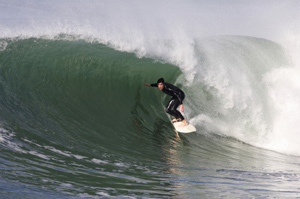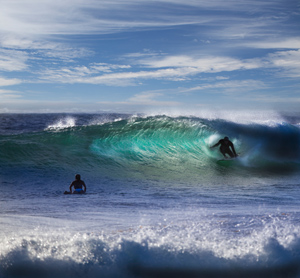How to Tube Ride in Surfing
The tube ride is surfing’s single greatest act; the supreme maneuver, the ultimate conquest. You could compare it to a home run, an overtime goal, or a buzzer-beating jump shot, but in reality, getting barreled is an event unparalleled by any sport on the planet.

For a surfer, life itself can amount to little more than the passing hours between tubes. Gliding through a churning, cyclonic tunnel of water is a sensation unlike any other, and there are plenty of wave riders who have given up everything – work, relationships, family – for a lifelong pursuit of the tube.
As uncomplicated as barrel riding appears, it is actually one of most difficult maneuvers to perfect because it requires a specific wave type (hollow), a high degree of courage, and an extraordinary sense of balance and timing. Although this guide will attempt to provide you with the knowledge needed to find a proper cover-up, there is no substitute for the one necessary component of becoming a good barrel rider: water time, and lots of it.
Wet Your Appetite
We’ll begin at the logical starting point, which is your ability to get wet as often as possible. Because barreling waves must pitch out with great force, they are inherently waves of consequence. Therefore if the conditions are right, you will inevitably find yourself in at least somewhat of a sketchy position.
Split-second decisions and ultra-fast reflexes are by far your greatest assets. This means that you need to be comfortable and clear headed when the waves are pumping, and the only way to achieve true calm in the eye of the storm is experience. Surf more. Conquer your fear of hollow waves by pulling into closeouts and surviving the impending destruction. Boards may break, reefs will be scraped, and sand will find its way into orifices you never knew existed. But it will all be worth it because at the end of the day, you’ll be one step closer to surfing nirvana.
Frontal Assault
Let’s dissect the easier of the two barrel approaches, the front side barrel. We will assume for all intents and purposes that our theoretical wave has a barrel section immediately after the take off.
- Your first priority when it comes to getting shacked is getting into the wave as early as possible. The earlier you’re able to get up on your board, the more time you’ll have to set your feet, eye a good line and set up for the oncoming tube section.
- Paddle hard – really hard. Dig, scrape, and put your paddling into overdrive as you work to get into the wave. Remember, the sooner you’re up and riding, the easier time you’ll have finding the barrel.
- As soon as you make it to your feet, keep your eyes focused down the line. Set your inside rail and execute an appropriate drop.
- Your drop will depend on what the wave is doing; if the wave is pitching immediately after takeoff, you’ll probably want to do a diminished bottom turn (or none at all) in order to tuck under the lip. If the wave is pitching out in front, a longer bottom turn may help you shoot into the barrel section with speed.
- Adjust your speed. Stall if you need to slow down and let the lip catch up. A kick-stall or a hand-stall will allow you to stay in sync with the wave. If the wave is pitching down the line, pump to gain speed.
- Once under the lip, it’s important to remember not to stop surfing. Keep adjusting your speed to stay high and tight in the tube.
- Find an exit. If the wave is closing out in front of you, break through the “doggy door.”
Backside Barrels

Backside tube riding is decidedly more difficult than the front side approach because you’re not facing the wave, so you really have to be in tune with exactly how the wave is breaking in order to successfully ride the barrel. Here are the basics:
- As with the front side approach, paddle hard and get into the wave as early as possible.
- Set your rail, and decide what kind of bottom turn you’ll need to execute, if any.
- If you need to tuck into a tight barrel, or if you need to stall, try the pig dog stance, as shown below. Drop your back knee and place your back hand on the outside rail for balance.
- Adjust your speed as needed. Do small pumps if you need to increase speed, and use a stall method, such as the hand or kick stall, in order to slow down.
- Find an exit, and continue surfing.
Shack Time
We’ve covered the basic points of riding the tube, but as emphasized earlier, the real learning will happen in the water. Remember to be safe, and don’t paddle out when the conditions don’t match your surfing ability. With patience and concentration, you can learn to execute one of the most intense and rewarding aspects of the sport of surfing.
